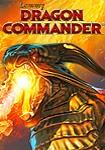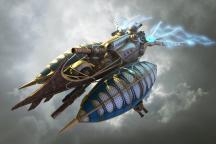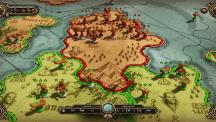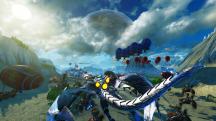Dragon Commander Multiplayer Review
For this review, I'll be focusing on the multiplayer campaign and skirmish mode, as Kalniel already dealt with the singleplayer campaign. Fortunately so, because I've been unable to get enough free time to play through the story - and as such, I will only touch lightly upon the aspects of the singleplayer game.
Apparently, I'm one of the relatively few people around the Watch who enjoys multiplayer - so I'll try to add some details for people who might share my perverse desire to share gaming with friends.
Overview
Well, now, this is a refreshing and delightful beast. It's a hybrid game, mixing real-time and turn-based strategy - and it's clearly inspired by board games like Risk and Civilization. As a refreshing twist, it adds arcade combat to the fray - and you get to manually control your very own Dragon Commander (nothing less than a jetpack-powered dragon) and the result is a surprisingly entertaining combination.
One of the dangers of combining genres that are so functionally different that they're usually kept separate - is that you're going to have watered down versions of at least one genre - and the result is not necessarily better than if you simply focused on but a single genre. Even with exceptions like the highly successful Total War series, I'd argue that you need a strong vision and a talented development team with diverse members to end up with more than the sum of the game's parts.
Larian had such a vision and such a team, it seems - because I consider Dragon Commander a successful merger of three different genres. Since each of these genres is so different from the others, I'll write about each of them separately, and sum up towards the end of the review. I think that makes sense for this game, and I hope you'll agree.
Multiplayer Campaign
The important differences between the singleplayer and multiplayer campaigns are that you have no story or roleplaying/political elements in the multiplayer campaign. As in, there's no "Raven" component - and you won't be interacting with NPCs or making political choices.
Beyond that, the two are identical.
The multiplayer campaign can have 2-4 players - and you can play alone against AI players if you so choose. For the review version of the game that I played, there were only 2 maps available - one small and one somewhat larger. I've been unable to verify whether this is still true for the release version.
As I'm very much a multiplayer gamer, I think it's time to talk about an unfortunate trend in modern MP games.
For whatever reason, it seems that if you're not developing an MMO - then multiplayer means 4 players at the most. I don't know exactly when this trend started, but the majority of games that advertise multiplayer as a main feature seem to share this limitation.Maybe it's just me - but I have several friends into multiplayer - and it's getting harder to find games that can hold all of us at once. I won't dwell on this - I just wanted to mention it, because Dragon Commander has this very same limit.
Anyway, as I mentioned - the MP campaign works just like the SP campaign with the Raven component removed. This means that you'll win the game by taking over the Capital country of each of your rival factions.
The campaign consists of three basic gameplay segments (the genres I talked about) - and these are: the turn-based strategy component, the real-time strategy component - and the arcade "shoot-em up" style component. I will delve into each of them in order of impact.
Turn-based strategy (board game)
This part of the game is what I would consider the core of the game - as it's not optional like the real-time combat - and it's also the most intricate and (in my opinion) most entertaining one. It's essentially a board-game designed for reasonably short sessions focusing on high playability - and it's clear to me that Larian kept multiplayer in mind throughout design and development.
I can say this with reasonable conviction for several reasons and one of them is that they've opted for simultaneous turns - meaning that each player will be playing and making decisions at the same time - and once they've all clicked "End Turn", those decisions are resolved simultaneously. This makes for a very playable multiplayer experience - and in my opinion, it's the best way to handle it. It minimizes waiting around and gives the game a good flow.
The game board represents a campaign map kept in true board-game style. It's divided into several countries - and each country has 3 desirable resources in different quantities. These are: Gold, Population and Research points. I really like the way they've displayed resources by marking each country like they were parts of a printed card-board map. In that same way, I think it was a good choice to represent military units by what looks like plastic pieces with a round base - and have typical strategy game elements like diplomacy, sabotage and spells be represented by cards - as it lends a tangible feeling to interacting with the game.
Gold is spent on buildings and military units; research is spent on..... you guessed it - research! But there are actually two kinds of research: unit research and dragon skill research. Population determines the amount of troops you can muster during the real-time combat component.
There aren't that many buildings to choose from - and a significant part of the strategy is to build the right one in each country - as they can only hold one.
For instance, the Gold Mine will double the output of gold in a given country - and since each country has its own amount of gold, you'll obviously want to build it where it will yield the most.
To recruit military units in a country, it needs to have a War Factory (or a Capital - which you can't build - and which you start with) - and you'll likely want your army-producing countries close to the front, so you can attack and defend with minimal delay.
Neutral countries are taken over by simply moving one or more army units into it - and if you're looking for something with a more "epic" pace like Civilization - you won't find it here. You can take over multiple countries each turn - and it's not uncommon to have the map completely taken over by player nations in less than an hour of playing. Again, this is a game about playability and not complexity. That's not to say it's an easy game - and making the right choices isn't trivial. I prefer to think of the design as elegant.
Beyond moving units and building stuff - you'll do some research. This is a relatively simple affair of spending research points on units, unit upgrades or dragon skills. You start the game capable of building only basic units - but it won't take long before you have enough points to unlock the higher tiers. Once you have unlocked a new unit - you can research powers for that unit, so as to make them more flexible and powerful.
Dragon skills are, basically, powers positioned on your combat hotbar in true MMO fashion. These vary from single target attacks to area-of-effect heals. Since you can only have a limited amount of powers in your hotbar - there's an added layer of strategy to bringing the right ones to a fight.
The last significant component of the turn-based game is the concept of cards. You can play cards that benefit yourself or harm your opponents. You also "research" these cards - but you don't do it by purchasing them with research points. Instead, you build specific buildings that add a random card of a given type (including combat cards and strategy cards) every few turns.
Since you have to build these buildings in a country - you should probably do it in ones that have low gold and research output.
The cards look exactly like those in a CCG (collectible card game like Magic the Gathering) - and this helps the board-game feel even more.
Strategy card effects include doubling the gold income of one of your countries for one turn, to sabotaging the production of an enemy country for one turn - and they're resolved like all your normal decisions, at the end of each turn.
Combat cards boost your troops or harm enemy troops - and Mercenary cards add unique units to your army during the real-time combat segment (also with auto-resolve). These cards are played just before combat begins.
That's it for the significant elements of the turn-based segment.
Once you move an army into an occupied enemy country - the game will prompt for battle as the turn resolves. This is where you decide whether to control the battle manually - or to lend control to one of your generals, which means it will be auto-resolved using your army and the combat cards you play before it starts. If you opt to fight manually, you will be faced with the real-time portion of Dragon Commander.
Real-time strategy
This part of the game is quite familiar to anyone having played games like Command and Conquer or Starcraft.
The game mostly resembles a cross between Supreme Commander and Starcraft - done in a visual style that looks sort of like Rise of Legends (if you know that one). You can zoom out quite a bit and you'll get icons representing your units - which is quite convenient, because your units are small and fickle looking for the most part.
Each map will have construction points on which you can build specific buildings - meaning you're not going to build your base freely - and I'd say that real-time strategy designation is a bit misleading, as it's really more about tactics than strategy. You build army-producing buildings on points meant for that - and you build defensive structures on defensive points. It's really quite straightforward.
Armies include light disposable troops, heavier troops, aerial units and naval units. Oh, and your Dragon Commander - which I will get into later on.
You can take over neutral or enemy construction points by moving near them - and depending on how many units you bring, the speed of take-over will differ. But it's quite fast no matter what - though you can adjust the speed in the options.
Your unit capacity will depend on the population of the country and the amount of "Recruitment Citadels" under your control. These are separate building built on specific points. These also determine the speed with which you build new units.
That's about it, really. The game tends to be very much about having the largest army - just like the old Command and Conquer used to be, but it doesn't have "special" units as such - beyond your Dragon Commander.
I find the real-time segment of the game barebones and not particularly fulfilling or exciting.
However, I concede that a simplified and fast-paced implementation is right for the game - because if combat took too long, or was too involved - the multiplayer campaign would have been unbearable at length. On a personal note, I would probably have handled turn-based vs. real-time combat differently, but I'll get into that in my summary.
That said, if you're not into multiplayer - I imagine you might find the real-time combat somewhat underwhelming and unsatisfying. Thankfully, you can auto-resolve in that case, but that would mean missing out on dragon combat.
This brings us to the Dragon Commander component.
Dragon Commander (arcade game)
When you're fighting a real-time battle manually - you have the capacity to summon yourself as a dragon and take part in the fight. You can't do this at will, exactly, as you need 20 unit points free - and you need to wait 2 minutes from the beginning of battle. However, that's rarely an issue - and it's not something the game tries to keep under tight control.
I think Larian really wanted you to go crazy with the dragon - and it's quite fun, I must say.
The controls are very easy - and you basically point with your mouse and move with the standard FPS setup (WASD) - though you can change this if you really want to. You can dodge as well.
Beyond pointing and clicking your mouse at enemies - you have your hotbar full of skills - and you have your jetpack (activated by the Space key). The jetpack makes you VERY fast - and you can easily move around the battlefield using it.
The most involved part of controlling your dragon is the hotbar. This is where you place the skills you've researched (as well as the basic ones you start with) - and they can make all the difference, especially against human players in control of their Dragon Commander.
Against the AI - the dragon is overpowered and can often turn the tide of battle, even if you begin without the odds in your favor. I think this is intentional, really.
I don't think Larian wanted the dragon to be insignificant - and I think it's all part of the levity of the game. Some players might differ, however - and I can't exactly know what Larian wanted here. I think brief battles work better in this game than if they'd tried to do a fantasy Total War game.
That's it for the three separate genres held within the game, but let me say something about the technical state of the game before I sum up my thoughts.
Skirmish mode and AI
Honestly, there really isn't much to say about the skirmish mode. It's simply the real-time strategy combat without the board-game. That's about it for the differences.
But I thought it might be an appropriate place to talk about AI - even though I don't think I've played enough to make a truly informed judgment. I thought it was reasonably aggressive and challenging - with the caveat that you can overcome a disadvantage with your dragon, given how you can target and eliminate the right units quite easily.
The AI of the board game segment moves pieces in a reasonably challenging way and it tends to be quite aggressive when you approach its Capital with an army. It starts building massive armies in defense - which is a good sign. It also seems to build building based on country resources - which is very important.
I can't say much more than that, and we all know that AI is something that will always change through patching - and it's never static in a game of popularity.
Interface, Visuals and sound
Dragon Commander is self-published and it's not a game with massive production values, so don't expect Starcraft 2 or Total War here.
But I think it's fair to say that the game is attractive and it pulls of the charm I think they went for. Especially during the Raven singleplayer segment - where the characters are quirky in just the right way, without necessarily winning any voice acting awards. But I'll let Kalniel's review go into that.
The campaign map looks like a real game board, armies look like board game pieces, cards look exactly like CCG cards and all in all, I think this game nails the atmosphere it's going for and it has a tangible feel like a real board game would have.
The real-time strategy combat looks decent enough, but it's not something that will make a big impression on a lot of people. I don't particularly care for the unit models - as they're too fickle and lack personality. They remind me of the units in Supreme Commander - though not quite that indistinct. But the terrain looks good - with nice water, and we all know that water should be pretty.
The Dragon Commander looks great, though - and there's a nice feel and flow to controlling him.
Sounds are functional - though I didn't notice much of note. I really like the music, however, as it's of an appropriately light and pleasant nature.
As for the interface, I'd say it's very good. The board game controls are very simple and straightforward, which is fortunate - because the manual is lacking in detail. Most things are self-explanatory - and it's a breeze to switch between the various menus needed to interact with the game.
The real-time controls are equally simple - and the camera is not hard to control. As I said, the Dragon Commander feels good - and it's very easy to fly around and hit things.
I had no performance issues whatsoever - and everything was smooth and responsive. But I do have a high-end setup - so I don't think that's of much use. I suspect it will run well on most setups - but obviously the low-end users should make sure to check out the requirements before purchasing the game.
All in all, I'd say the technical state of the game is above average - and quite impressive for a self-published title with a limited budget. I didn't encounter much in the way of bugs - but given that it wasn't the final version - I think you should check out other reviews for details on these issues.
Summary
I really like this game.
While I don't think it's a masterpiece and I don't think anything it does is particularly impressive - I admire its vision and its very existence given the circumstances of the modern gaming industry.
This is a brave project in financial terms - because it doesn't really resemble a game that would appeal to a wide audience, and it's such an unusual mixture of elements that it can't be too easy to market to the masses.
So, Larian has taken a chance here and followed their vision. The style is consistent and from what I understand of their goals with this game - it succeeds in most ways. I say most ways, because I personally think the real-time combat (minus the Dragon Commander) is somewhat weak and I suspect it's there simply because they wanted to have that dragon under your control. I can't deny that the dragon works well, but I would have preferred a more intricate board game and a combat system that was more hands-off like Dominions 3 or Warlords 3.
That's just me, however, and I imagine a lot of players having more fun with the dragon - and it does add a refreshing change to multiplayer combat.
I think it's worth buying if you're into board games and multiplayer strategy games. If you're primarily a real-time strategy fan, you MIGHT want to check it out - just realize that it's not the most involved example of the genre.
If you're just looking for some fun and you want to support developers with artistic integrity - I can highly recommend Dragon Commander.

Information about
Divinity: Dragon CommanderDeveloper: Larian Studios
SP/MP: Single + MP
Setting: Steampunk
Genre: Strategy-RPG
Combat: Real-time
Play-time: Unknown
Voice-acting: Full
Regions & platforms
World
· Homepage
· Platform: PC
· Released: 2013-08-06
· Publisher: Larian Studios
More information
Other articles
Summary
Pros
- Multiplayer well integrated and not an afterthought
- Board-game feel with a pleasant flow
- Doesn't get bogged down in minutia
- Quirky charm
Cons
- Underwhelming RTS segment
- Units lack distinction and style
- 4-player limit in multiplayer campaign/skirmish







